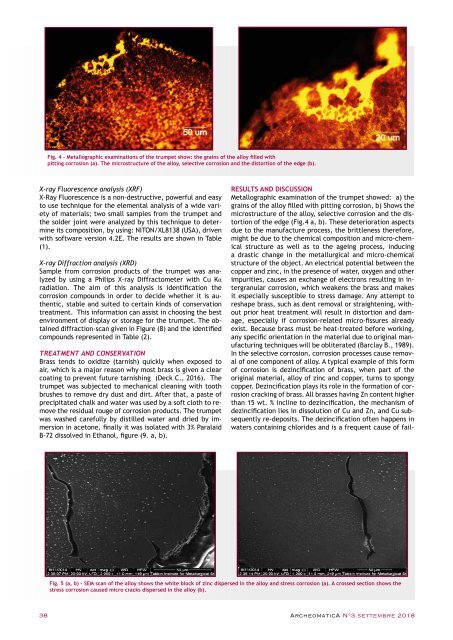Archeomatica_3_2018
You also want an ePaper? Increase the reach of your titles
YUMPU automatically turns print PDFs into web optimized ePapers that Google loves.
Fig. 4 - Metallographic examinations of the trumpet show: the grains of the alloy filled with<br />
pitting corrosion (a). The microstructure of the alloy, selective corrosion and the distortion of the edge (b).<br />
X-ray Fluorescence analysis (XRF)<br />
X-Ray Fluorescence is a non-destructive, powerful and easy<br />
to use technique for the elemental analysis of a wide variety<br />
of materials; two small samples from the trumpet and<br />
the solder joint were analyzed by this technique to determine<br />
its composition, by using: NITON/XL8138 (USA), driven<br />
with software version 4.2E. The results are shown in Table<br />
(1).<br />
X-ray Diffraction analysis (XRD)<br />
Sample from corrosion products of the trumpet was analyzed<br />
by using a Philips X-ray Diffractometer with Cu Kα<br />
radiation. The aim of this analysis is identification the<br />
corrosion compounds in order to decide whether it is authentic,<br />
stable and suited to certain kinds of conservation<br />
treatment. This information can assist in choosing the best<br />
environment of display or storage for the trumpet. The obtained<br />
diffraction-scan given in Figure (8) and the identified<br />
compounds represented in Table (2).<br />
TREATMENT AND CONSERVATION<br />
Brass tends to oxidize (tarnish) quickly when exposed to<br />
air, which is a major reason why most brass is given a clear<br />
coating to prevent future tarnishing (Deck C., 2016). The<br />
trumpet was subjected to mechanical cleaning with tooth<br />
brushes to remove dry dust and dirt. After that, a paste of<br />
precipitated chalk and water was used by a soft cloth to remove<br />
the residual rouge of corrosion products. The trumpet<br />
was washed carefully by distilled water and dried by immersion<br />
in acetone, finally it was isolated with 3% Paralaid<br />
B-72 dissolved in Ethanol, figure (9. a, b).<br />
RESULTS AND DISCUSSION<br />
Metallographic examination of the trumpet showed: a) the<br />
grains of the alloy filled with pitting corrosion, b) Shows the<br />
microstructure of the alloy, selective corrosion and the distortion<br />
of the edge (Fig.4 a, b). These deterioration aspects<br />
due to the manufacture process, the brittleness therefore,<br />
might be due to the chemical composition and micro-chemical<br />
structure as well as to the ageing process, inducing<br />
a drastic change in the metallurgical and micro-chemical<br />
structure of the object. An electrical potential between the<br />
copper and zinc, in the presence of water, oxygen and other<br />
impurities, causes an exchange of electrons resulting in intergranular<br />
corrosion, which weakens the brass and makes<br />
it especially susceptible to stress damage. Any attempt to<br />
reshape brass, such as dent removal or straightening, without<br />
prior heat treatment will result in distortion and damage,<br />
especially if corrosion-related micro-fissures already<br />
exist. Because brass must be heat-treated before working,<br />
any specific orientation in the material due to original manufacturing<br />
techniques will be obliterated (Barclay B., 1989).<br />
In the selective corrosion, corrosion processes cause removal<br />
of one component of alloy. A typical example of this form<br />
of corrosion is dezincification of brass, when part of the<br />
original material, alloy of zinc and copper, turns to spongy<br />
copper. Dezincification plays its role in the formation of corrosion<br />
cracking of brass. All brasses having Zn content higher<br />
than 15 wt. % incline to dezincification, the mechanism of<br />
dezincification lies in dissolution of Cu and Zn, and Cu subsequently<br />
re-deposits. The dezincification often happens in<br />
waters containing chlorides and is a frequent cause of fail-<br />
Fig. 5 (a, b) - SEM scan of the alloy shows the white block of zinc dispersed in the alloy and stress corrosion (a). A crossed section shows the<br />
stress corrosion caused micro cracks dispersed in the alloy (b).<br />
38 ArcheomaticA N°3 settembre <strong>2018</strong>


















